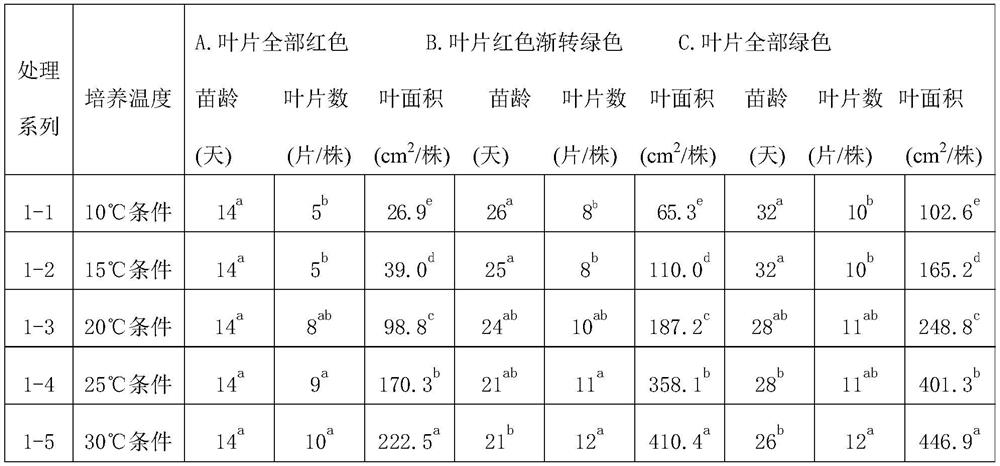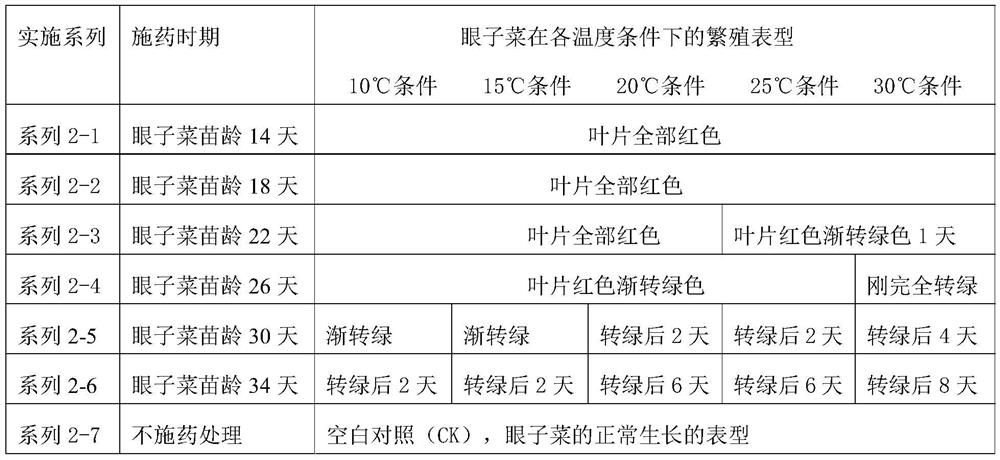A method of reducing the application of herbicides and increasing the efficiency of the control of Paddy-field Sternia chinensis
A kind of technology of eye vegetable and herbicide, which is applied in the field of plant protection of farmland weed control, can solve the problems of crop phytotoxicity, large amount of pesticide usage, agricultural product quality safety and ecological environment safety threat, etc. Efficient effect
- Summary
- Abstract
- Description
- Claims
- Application Information
AI Technical Summary
Problems solved by technology
Method used
Image
Examples
Embodiment 1
[0030] Example 1 Observation on the vegetative propagation of the seedlings of the prickly pear under different temperature conditions
[0031] Test material: Control of Potamogeton distinctus A. Benn. is a perennial aquatic plant of Potamogetonaceae (Potamogeton L.), which is the dominant vicious weed population in the japonica rice area of Yunnan Province. The material is mature seeds collected from the weed preservation nursery of Yunnan Academy of Agricultural Sciences.
[0032] Test method: Based on preliminary observations on the growth and development of Pseudomonas japonicus in paddy fields at different altitude gradients in Yunnan Province, the present invention further simulates the experiment to observe the differences of Pseudomonas japonica seedlings under different temperature conditions (see implementation series 1-1~1- 5). The details are as follows: select 20 evenly matured waterweed seeds (row spacing 4×4cm) and sow them in a plastic box of 20cm×20cm×15cm with ...
Embodiment 2
[0043] Example 2 Comparison of the control effect of Promethazine on the control of Pseudomonas sp.
[0044] Test materials: According to the observation results of the vegetative propagation characteristics of the prickly pear seedlings under different temperature conditions in Example 1, the present invention further determines the control effect (%) of promethazine applied in different periods on the prickly pear. During the 14-34-day growth period of the prickly pear seedlings, one application period was set every 4 days (a total of 6 series designs). The tested herbicide was 50% Promatogin (WP) produced by Kunming Pesticide Factory. It was applied in accordance with the conventional effective dosage (50g ai / mu) in the production and sprayed with a quantitative spray tower. The spray volume was 10ml / 0.198. m 2 . After sown, the waterweed was cultivated in an artificial climate box with simulated different temperatures (10℃, 15℃, 20℃, 25℃, 30℃), and each treatment was repeate...
Embodiment 3
[0052] Example 3 Toxicity determination of different dosages of Promethazine on Pseudomonas
[0053] Test material: The test herbicide Prometheus and its control target Potentilla vulgaris material are the same as in Example 2.
[0054] Test method: "Pesticide Bioassay Method" (edited by Shen Jinliang, 2013) on the dose-virulence regression method. Select the three periods of obvious reproductive phenotypic characteristics after the leaves are red, the leaves gradually turn green, and the leaves turn completely green to test the net virulence of promethazine, that is, when the age of the seedlings is 14, 24, and 34 days. Application of herbicides. The promethazine applied in each period is set to 5 dosage levels according to the dosage, see the implementation series 3, respectively, 25.0, 35.0, 45.0, 55.0 and 65.0 g ai / mu. Each dose level is calculated and accurately weighed according to the exact two decimal places of the potted area of the waterweed, then dissolved in a solve...
PUM
 Login to View More
Login to View More Abstract
Description
Claims
Application Information
 Login to View More
Login to View More - R&D
- Intellectual Property
- Life Sciences
- Materials
- Tech Scout
- Unparalleled Data Quality
- Higher Quality Content
- 60% Fewer Hallucinations
Browse by: Latest US Patents, China's latest patents, Technical Efficacy Thesaurus, Application Domain, Technology Topic, Popular Technical Reports.
© 2025 PatSnap. All rights reserved.Legal|Privacy policy|Modern Slavery Act Transparency Statement|Sitemap|About US| Contact US: help@patsnap.com



